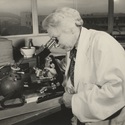This timeline provides a look at some of the key advances in ideas about light, how we see and how we perceive the world around us.
400 BC – Emission theory of vision
Greek philosopher and mathematician Plato develops the emission theory1 of vision – we see because our eyes emit straight vision beams.
300 BC – First writings about reflection and refraction
Greek mathematician Euclid writes Optica. He asserts that light travels in straight lines and proposes mathematical formulae for reflection2 and refraction3.
160 AD – Ptolemy and refraction
Roman astronomer Ptolemy writes about the refraction of light and further develops the emission theory of vision – objects are seen by rays of light emanating from the eyes.
984 – Ibn Sahl and refraction
Persian scientist Ibn Sahl writes On burning mirrors and lenses, which sets out his understanding of how curved mirrors and lenses bend and focus light. He discovers a law of refraction mathematically equivalent to Snell’s law4 (1615).
1021 – Intromissionist theory
Arab scientist Ibn al-Haytham contends that vision occurs because of rays entering the eye (intromissionist theory). He also contends that magnification is due to refraction, and he makes the link between glass curvature and magnification.
1250 – Roger Bacon and reflection
English philosopher Roger Bacon uses parts of glass spheres as magnifying glasses and discovers that light reflects from objects rather than being released from them.
1604 – How the eye focuses light
German mathematician and astronomer Johannes Kepler describes how the eye focuses light and specifies the laws of rectilinear propagation5 of light.
1615 – Snell’s law
Snell’s law (named after Dutch astronomer Willebrord Snellius but first accurately described by Ibn Sahl in 984) describes the relationship between the angles of incidence and refraction when referring to light passing through a boundary between two different media.
1668 – Corpuscular theory expanded
Isaac Newton expands the theory originally set forward by Pierre Gassendi that light is made up of small discrete6 particles called ‘corpuscles’ to claim that light is made up of different parts.
1672 – Colours explained
Isaac Newton demonstrates how white light can be separated into a spectrum of colours with a prism. He develops ideas about different colours of light being absorbed, transmitted or reflected. His book Opticks is released to the public in 1704.
1678 – Wave theory
Dutch physicist Christiaan Huygens argues that light consists of waves and uses this theory to explain double refraction. Thomas Young’s experiments (1801) support Huygens’s wave theory.
1860 – Electromagnetic field
James Clerk Maxwell explains that electricity7, magnetism8 and light are all manifestations of the same phenomenon – the electromagnetic field.
1899 – Planck’s theory
Max Planck models black body radiation9 by assuming that the exchange of energy between light and matter10 only occurs in discrete amounts he called quanta.
1905 – Interpretation of the photoelectric effect
Albert Einstein publishes a mathematical description of the photoelectric effect11. This establishes that light consists of particles or ‘discrete quanta’. These particles later became known as photons.
1922 – First 3D movies
William Friese-Greene files a patent12 for a 3D movie process in the late 1890s, Louis Ducos du Hauron invents red and blue glasses for 3D in 1915, and the first public 3D movie is screened in 1922.
1925 – First television
John Logie Baird demonstrates the first operating television system in London.
1960 – First working laser
Theodore Maiman produces the first working laser. A laser has the ability to generate an intense, very narrow beam of light of a single wavelength13.
2010 – 3D televisions
The first full 3D TVs with use of shutter technology become available.
- theory: To scientists, a theory provides a coherent explanation that holds true for a large number of facts and observations about the natural world. It has to be internally consistent, based upon evidence, tested against a wide range of phenomena and demonstrate problem solving.
- reflection: 1. The change in direction, or bouncing back of a wave when it strikes a surface. 2. Mirroring. 3. Casting back, as in light or heat.
- refraction: The bending of a wave as it passes from one medium to another. Refraction signifies a change in velocity (speed) of the wave.
- Snell’s law: Snell’s Law of Refraction is expressed as n 1sinθ1 = n 2sinθ2. The law states that, for waves passing from one medium to another, the ratio of the sine of the angle of incidence and the sine of the angle of refraction is constant.
- propagation: Increasing plant numbers using seeds, cutting, division, grafting or other methods. Can be sexual (for example, seeds) or asexual (for example, grafting). Asexual propagation results in many plants that are genetically identical (clones).
- discrete: Separate or distinct.
- electricity: A general term that includes a variety of phenomena resulting from the presence and flow of electrical charge.
- magnetism: A force created by the motion of electrons, generating a magnetic field that influences magnetic objects such as iron and other metals.
- radiation: Energy that is transmitted (radiates) from a source in the form of rays or waves or particles.
- matter: The basic structural component of all things that have mass and volume.
- photoelectric effect: Given the right conditions, when light with sufficient energy is shone onto a metal surface, electrons can be emitted or ejected from the surface of the metal. The energies of the emitted electrons are independent of the intensity of the incident light.
- patent: A document granting the inventor sole rights to protect an invention and prevent others from making, using, selling or claiming it as theirs.
- wavelength: The distance between two successive points of a wave (from one peak or crest of a wave and the next peak or crest). Usually refers to an electromagnetic wave, measured in nanometres (nm).






